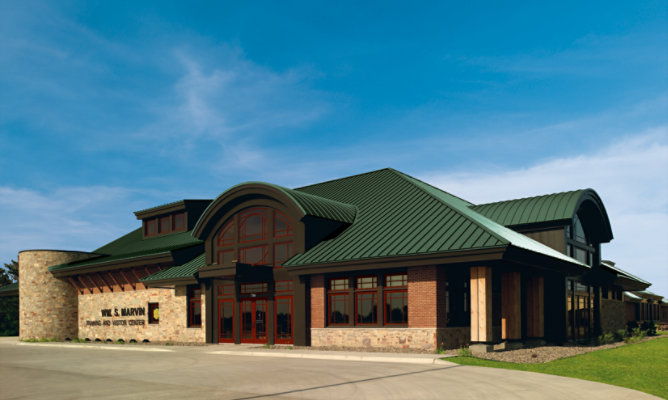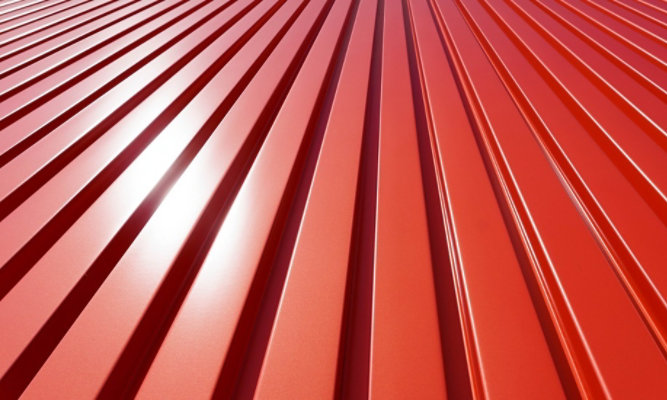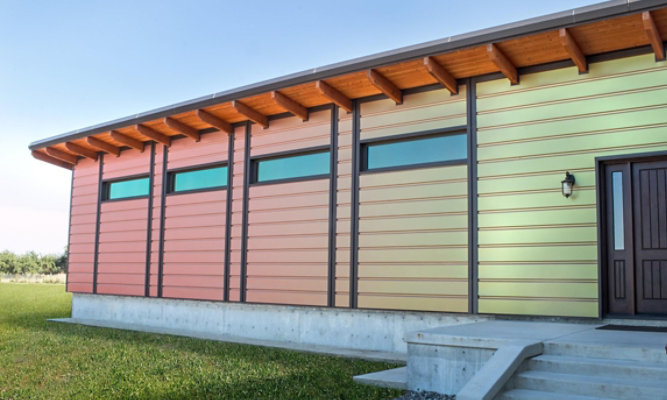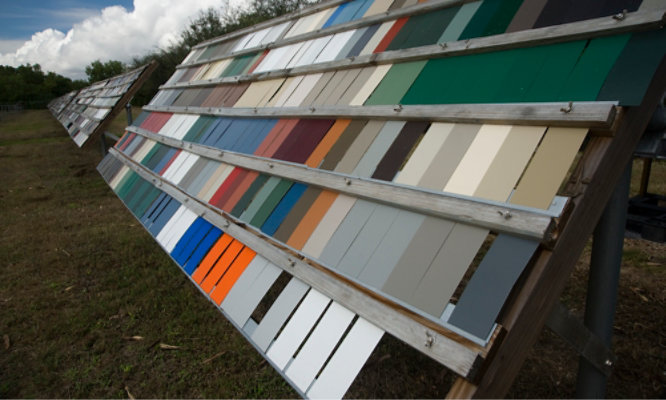The Benefits of Metal Roofs and Coatings
Recognised as sustainable, durable building components, metal roofs are used in various applications.
The performance of the assembly's panels depends on the metal substrate, metallic layer, and exterior coating. These are critical to the panel's weather and corrosion resistance, colour retention, and overall longevity.
Finished with the proper coating system, ‘cool’ metal roofs can also help reduce a building’s carbon footprint, energy consumption, and cooling/heating loads. In addition to directly benefiting the building owners and occupants, these roofs also assist in benefiting the surrounding community by mitigating the urban heat island effect.
Metal roofing substrates
Metal roofs can last longer than most non-metal roofing products. Their materials contain recycled content and are 100 percent recyclable at the end of their useful life. Metal roofs can be designed to withstand extreme weather conditions and are more fire-resistant than other roofing materials such as wood or asphalt. A metal roof can be one-eighth the weight of other roofing products, placing a lighter load on the structure and foundation and extending the life of the entire building. The lightweight system also makes them easier to transport and install, further saving on time, as well as financial and environmental costs.
Steel and aluminium are both used in the manufacture of metal roofs, with the former being the most common. In weight, pound for pound, steel is economical metal roofing. Steel’s strength and durability throughout its service life, as well as its lifecycle cost, make it an attractive investment. Steel and aluminium are amongst the most recycled materials in the world with more than 50 percent of steel supply in the United States and 40 percent of the aluminium supply in North America being produced through recycled sources¹.
Corrosion can affect the structural integrity and durability of roof metals and alloys. Localised corrosion can lead to pitting, cracking, and eventual fractures, causing leakage or more serious failure of building components. The metal roofing substrate can be protected from corrosion with one of two types of protective metallic coatings: sacrificial and/or barrier protection.
Sacrificial protection involves having a protective metallic coating that gets attacked by corrosion, instead of the steel. Eventually, this sacrificial coating will be completely corroded away, leaving the bare steel to rust. Barrier protection is intended to repel the corrosive media. There is little attack by the corrosive media on the barrier-type coating.
Galvanised coatings are metallic coatings most popularly used to protect metal roofs from corrosive media. This type of coating is a zinc-based metal covering that comes in either G60 or G90 of zinc of the total area covered and is a sacrificial coating.
Coatings containing a five percent aluminium-zinc alloy also serve as a sacrificial coating. Another type of coating is an aluminium-zinc alloy composed of 55 percent aluminium to 45 percent zinc; it is produced in either AZ50 or AZ55 coating weights. This 55/45 percent aluminium-zinc alloy coating functions both as a sacrificial and a barrier coating, with its zinc providing protection on exposed edges or scratches and its aluminium providing a barrier to corrosive media.
Exterior coatings
Exterior coatings further enhance a metal roof’s aesthetic and performance characteristics. To ensure uniform gloss, colour, and thickness, a coil-coat process is the preferred application method for metal roofing. Using this method, the rolls of metal are painted prior to them being shaped into the roof panels. These pre-painted sheets of steel or aluminium can be cut, slit-formed, corrugated, profiled, and moulded into shingles, shakes, curves, and various shapes for distinctive architectural designs.
Exterior coatings for metal roofs are composed of four main elements: resin, pigment, solvents, and additives. The pigment particles are suspended within the resin, and the mixture is then reduced to a liquid form, providing an easy application to a metal surface.
The resins primary function in a paint formulation is to bind together all the components within the coating. It is the primary source for a coating’s durability and physical properties. Resin increases the physical strength and chemical resistance of the coating film, and allows the chemical reaction of the curing process.
Common resins used in the manufacture of paint coatings for metal roofing include:
Plastisols: these are well-suited for areas with a need for chemical-resistance or barrier properties are (e.g., industrial applications); Polyester and resins: used in many different metal roofing applications, but are formulation-specific in their balance of performance and economic criteria; Polyvinylidene fluoride (PVDF) resins: withstanding extended exterior exposure to water, humidity, temperature, ultraviolet (UV) light, oxygen, and atmospheric pollutants frequently specified for metal roofs — for a standard, high-performance PVDF resin-based coating, 70 percent of the resin is PVDF and 30 percent is acrylic; FEVE resins are resistant to the exterior elements, and have a low permeability to oxygen, water, and chloride — they also offer a higher gloss and wider colour range compared with PVDF resin-based coatings on metal roofs; and Silicone-modified polyester (SMP) coatings: not as formulation-specific as polyester and acrylic, more economical than PVDF and fluoroethylene vinyl ether (FEVE) resins, offer good weather resistance, and are harder than most other film options available for metal roofing.
Finished with the proper coating system, ‘cool’ metal roofs can also help reduce a building’s carbon footprint, energy consumption, and cooling/heating loads.
These coatings discussed are original equipment manufacturer (OEM) factory- applied. PVDF and SMP are the most common coatings for metal roofing in the industry.
Topcoat pigments yield the colour of paint. In addition to helping provide the aesthetic of an application, pigment also provides opacity by either absorbing or reflecting light. This helps ensure a longer life for the coating. The pigments used will also affect the coating system’s resistance to fade. Organic pigments have a bright appearance, but a low resistance to fade. Inorganic, or ceramic, pigments are less bright and more earth-toned, but have a high resistance to fade.
The solvent used in exterior coatings primarily serves as a diluent to maintain and control the paint’s viscosity for ease of application. As the solvent dissolves, it disperses solid resins to help the paint coalesce. During the curing process of a metal roof coating, the solvents are safely captured and incinerated, leaving the pigment and resins on the substrate.
‘Additives’ is an umbrella term encompassing extra agents that can be formulated into paint to enhance its performance. Some additives can be used to control foam, flow, and levelling of the paint as it is being applied. Viscosity modifiers are used to improve settling and catalysts are added to accelerate a chemical reaction.
Performance expectations
When selecting an exterior coating for a metal roof system, it is important to know how it stands up to the potentially destructive factors of the outdoors. A reputable vendor for coatings will offer warranties on all of its products, as well as CSI three-part format specifications to ensure optimal performance.
Coating manufacturers’ specifications will reference ASTM test protocols for evaluating such qualities as:
- specular gloss;
- colour consistency;
- adhesion;
- film hardness and thickness;
- flexibility;
- water-resistance;
- abrasion-resistance;
- chemical-resistance;
- salt-spray and corrosion-resistance; and
- chalking.
For example, chalking occurs when the resin system at the surface of the paint’s finish starts to degrade. This largely is caused by exposure to UV rays. As the resin system breaks down, resin particles take on a white appearance, and embedded pigment particles lose their adhesion to the film. With this breakdown in adhesion, particles begin to come off the film’s surface, referred to as chalk.
Fading is caused when substances in the environment attack the pigment in the paint. This leads to a change in the colour of the paint itself. The chemical spot test determines a film’s resistance to high acidic or corrosive conditions. A concentrated acid or base is dropped onto the film and covered with a watch glass. After a prescribed period, the panel is wiped off and examined for damage or discoloration. FEVE resins are particularly resistant to corrosive conditions, and their inert quality means they will not change during a chemical spot test.
In addition to ASTM test protocols and coating manufacturers’ specifications, standards and guidelines are available from industry associations, government agencies, and various metal roofing manufacturers to inform decision-makers about their coating selections and how exterior coatings should be expected to perform when exposed to various climate conditions over time.
When testing how a coating’s colour changes based on its exposure, samples are cast on a pre-coated primer. Colour instrumentation is then used to measure the colour of a batch of paint versus the standard, in three scales:
• light to dark (or white to black);
• red to green; and
• yellow to blue.
Any colour coating can be scored by a number based on where it falls on each of these scales.
Many coating manufacturers’ warranties cite Delta E on their paint, which refers to the change in the colour from when it dried to its current length of exposure. Delta E quantifies the difference between two colours, such as the unexposed reference and the colour after exposure. A Delta E of 1.0 is typically the smallest colour difference the human eye can see. The combination of sun, heat, and moisture affects the colour shift in Delta E and damages the roof’s coating far more quickly than any one factor alone.
Environmental considerations
The primary environmental concern with liquid coil coatings is the solvents used. Some of these solvents are considered volatile organic compounds (VOCs), which have been associated with ozone depletion when released directly into the atmosphere. When coil coatings are applied by responsible finishing facilities, the VOCs are safely captured and incinerated before the painted material leaves the factory. In some cases, the heat from incineration is then re-used to heat different parts of the coating process.
The coating selection for metal roofs can also have positive environmental advantages. Until recently, the roof has been one of the least energy-efficient components of the building envelope. Seeing the opportunity for innovation, options such as ‘cool’ metal roofs have come to the forefront of commercial building design.
A cool roof is one reflecting the heat emitted by the sun back into the atmosphere, keeping the roof’s temperature lower, thereby reducing the amount of heat transferred into the building space below. Cool roof requirements appear in national and local energy codes, green building initiatives, and energy rebate programmes because a cool roof reduces air-conditioning use and lowers utility bills. It also mitigates the urban heat island effect, where roof and pavement surfaces retain heat, which in turn, contributes to elevating temperatures, increased greenhouse petrol (GHG) emissions, and local climate disruptions. Cool roofs minimise these adverse effects, while increasing occupant comfort and reducing the occurrence of health issues associated with poor air quality and smog.
There are two key properties important to the temperature a roof will reach in direct sunlight:
• solar reflectance (SR) — the amount of solar energy immediately reflected from a surface; and
• thermal emittance (TE) — the amount of heat energy a surface can re-emit in the form of infrared (IR) energy into the atmosphere.
A cool roof with a high SR and a high TE will have a lower surface temperature compared to that of a roof with a low SR and a low TE. A lower surface temperature translates into less heat gain into the structure below, resulting in a cooler building, which means less energy used and lower energy bills.
Research by the Oak Ridge National Laboratory’s (ORNL) Buildings Technology Centre shows metal roofing retains SR better over time than any other roofing product.² Enhancing this performance, coil coatings for SR metal roof are available with 70 percent PVDF resins and solar reflective pigments. Depending on colour, many cool roof applications will specify a two-coat, factory-applied, oven-baked finish with a minimum SR value of 0.25 and TE value of 0.85 to 0.90 for typical coatings.
Energy not reflected away or re-emitted can heat a roof’s surface, whereby the flow of ambient air causes convection heating, potentially contributing to higher urban temperatures. A heat island describes built-up urban areas that are hotter than their surrounding rural areas. According to the U.S. Environmental Protection Agency (EPA), the annual mean air temperature of a city with one million people or more can be 1 to 3 C (1.8 to 5.4 F) warmer than its surroundings. In the evening, the difference can be as high as 12 C (22 F). The elevated temperatures can result in higher energy costs to cool buildings for the entire city.³
The EPA’s Energy Star Reflective Roof programme’s qualifying criteria for a cool roof are:
• low-slope — less than 2:12 pitch — roofs must have initial SR of 0.65 and an SR of 0.50 after three years of service life;
• steep-slope — 2:12 pitch or greater — roofs must have an initial SR of 0.25 and an SR of 0.15 after three years of service life.
Metal roof criteria for Leadership in Energy and Environmental Design (LEED) are:
• low-slope roof < 2:12 solar reflectance index (SRI) requirement is 78; and
• steep-slope roof > 2:12 SRI requirements is 29.
SRI combines reflectivity and emittance to measure a roof’s overall ability to reject solar heat. The calculation of this index is defined by ASTM E1980, Standard Practice for Calculating Solar Reflectance Index of Horizontal and Low- Sloped Opaque Surfaces, and is based on a formula including values for solar reflectivity and thermal emissivity. Standard black (reflectivity five percent, emittance 90 percent) has an index of 0, and standard white (reflectivity 80 percent, emittance 90 percent) has an index of 100.
Improvements to SR values can be made through cool pigment technology. The impact of increased SR of a roof can compound quickly.
For every 0.01 increase in SR, the surface temperature decreases 0.3 to 0.6 C (0.5 to 1 F). For every 0.10 increase in SR, cooling and heating energy costs drop $0.02/1 m2 ($0.02/sf), in warm climates. Cool roofing can also contribute to lower maintenance costs and extended roof life, along with the long-term environmental advantages.4
Conclusion
Achieving the desired benefits and intended performance of cool metal roofs requires thoughtful specification, carefully selected raw materials suppliers and close collaboration with experienced coatings manufacturers. Through this collaboration, specification professionals can meet both the building team’s expectations and their ideals of contributing to a better urban environment.
Featured Articles
Sherwin-WIlliams Coil Coating
Check out other educational articles from Sherwin-Williams
Go to Media Centre







